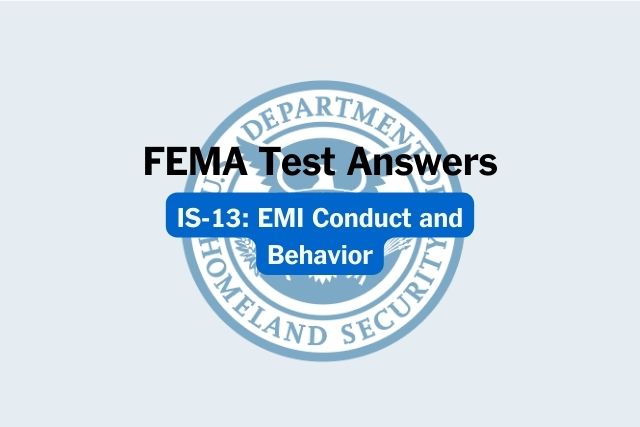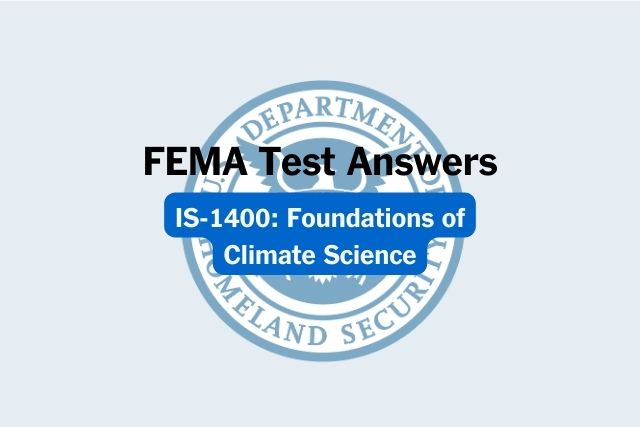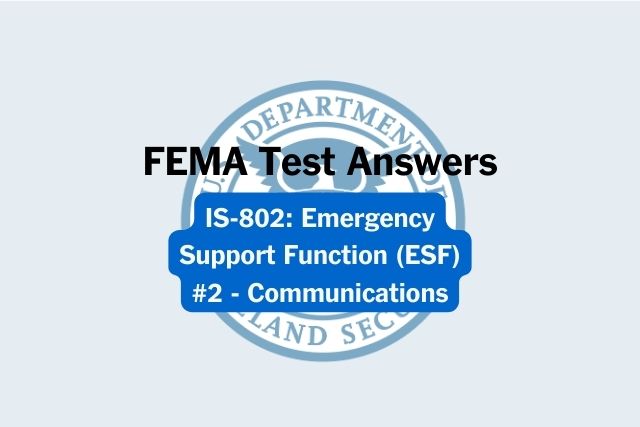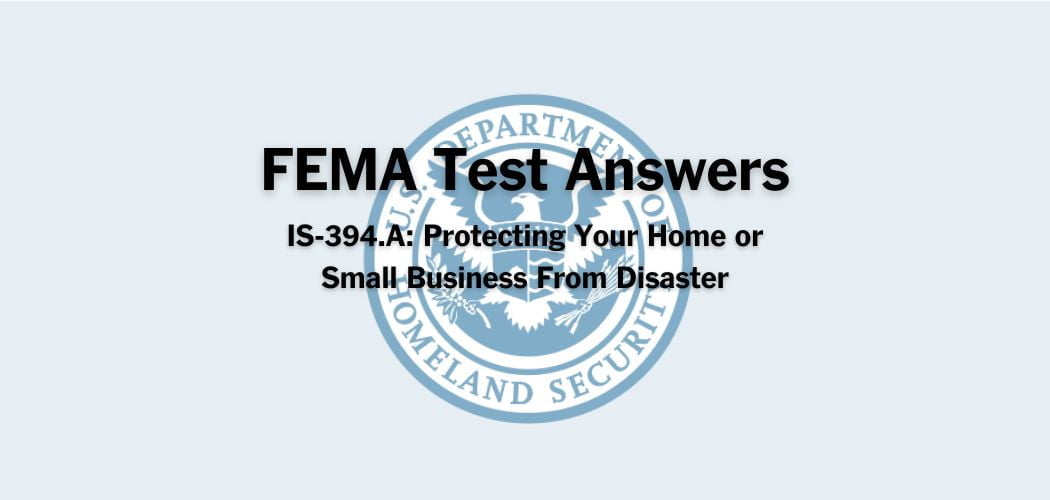Overview: The FEMA IS-29.A course was published on 8/5/2019 to familiarize participants with the concepts underlying the PIO role. This course can provide a basic understanding of the PIO function for those new to the position. Additionally, it can provide those in executive-level roles with the necessary knowledge of PIO roles and responsibilities during an emergency.
Primary audience: FEMA IS-29.A is designed for the new or less experienced state, local, tribal and territorial PIOs or those who have this role as a secondary function. Participants will benefit from participating in entry-level incident command system training prior to taking this course.
FEMA IS-29.A test answers
Each time this test is loaded, you will receive a unique set of questions and answers. The test questions are scrambled to protect the integrity of the exam.
Question 1. Select the correct definition – Public Information
A. Coordinates the release of accurate, coordinated, timely, and accessible public information to affected audiences, including the government, media, non-governmental organizations (NGOs), and the private sector
B. Information developed and disseminated in anticipation of, during, or after an emergency to provide specific life- and health-saving information✅
C. Issuing a news release on a seatbelt law (public information); announcing a road closure due to a multiple-car accident (emergency public information)
D. Information collected, assembled or maintained by an organization in connection with the transaction of official business and available for dissemination to the public
Question 2. Communication with internal agency personnel is
A. not a role undertaken by a PIO.
B. an important part of the PIO’s job.
C. only required when dictated by the Incident Commander.
D. a required responsibility of the PIO as outlined by NIMS.✅
Question 3. Social Marketing
A. theory is an important component of the strategic communications planning process.✅
B. requires in-depth focus groups to focus the message.
C. is a failed theory and should not be used by modern public information officers.
D. is only useful on television infomercials.
Question 4. A PIO’s proactive approach to public information enhances credibility in messaging. Proactivity occurs during
A. The five (5%) segment of the 95/5 concept
B. downtime when working an emergency.✅
C. “blue sky” time but makes no difference in credibility.
D. The ninety-five (95%) segment of the 95/5 concept
Question 5. Studies show that people read differently online than when they read printed materials, therefore, when you write for the Web or social media you should:
A. Use jargon to communicate with your target audience
B. Avoid visuals
C. Chunk content to make it more scannable✅
D. Maximize search results by using acronyms
Question 6. Organizing the information in a news release so that the important information comes first is called:
A. AP style
B. Inverted pyramid✅
C. JIC style
D. Journalistic style
Question 7. Select the correct definition – Emergency Public Information
A. Coordinates the release of accurate, coordinated, timely, and accessible public information to affected audiences, including the government, media, non-governmental organizations (NGOs), and the private sector
B. Information developed and disseminated in anticipation of, during, or after an emergency to provide specific life- and health-saving information✅
C. Issuing a news release on a seatbelt law (public information); announcing a road closure due to a multiple-car accident (emergency public information)
D. Information collected, assembled, or maintained by an organization in connection with the transaction of official business and available for dissemination to the public
Question 8. A Public Information Officer (PIO) for a public safety or emergency management agency might expect to spend what portion of his or her time on activities directly related to incident response or recovery?
A. 95%
B. 50%
C. 25%
D. 5%✅
Question 9. The public information officer for an organization
A. should clear all public documents with neighboring agencies before release.
B. is not bound by public record laws.
C. will transfer to a planning position if no media covers an incident.
D. should be knowledgeable, assertive, credible, flexible, able to perform under pressure, and accessible.✅
Question 10. Social marketing is the use of commercial marketing principles to:
A. Promote government programs and activities
B. Influence an audience to modify behavior✅
C. Sell government or nonprofit products and programs
D. Enhance social media
Question 11. “The most important point is …” is an example of a transition phrase or:
A. Sound bite
B. Speculation
C. Summarizing
D. Bridging✅
Question 12. Under the ICS, the PIO works for:
A. The Incident Commander✅
B. The highest-ranking State official
C. His/her regular boss
D. The Operations Section Chief
Question 13. The PIO’s primary responsibility to organizational leadership as an advisor is to:
A. Develop relationships with other organizations PIOs
B. Set up interviews and write talking points
C. Be an intermediary between leadership and the news media✅
D. Assess situations for public information implications
Question 14. Select the correct definition – External Affairs
A. Coordinates the release of accurate, coordinated, timely, and accessible public information to affected audiences, including the government, media, non-governmental organizations (NGOs), and the private sector✅
B. Information developed and disseminated in anticipation of, during, or after an emergency to provide specific life- and health-saving information
C. Issuing a news release on a seatbelt law (public information); announcing a road closure due to a multiple-car accident (emergency public information)
D. Information collected, assembled, or maintained by an organization in connection with the transaction of official business and available for dissemination to the public
Question 15. Communicating public information messages internally to the workforce is important because it allows the PIO to:
A. Test the message on a ” safe” audience
B. Add to the measurable statistics
C. Enlist support and involvement of organization personnel while communicating a consistent message✅
D. Demonstrate commitment to the organization
Question 16. One of the advantages of the Incident Command System (ICS) is:
A. It provides a framework for people from multiple agencies to work well together✅
B. It uses organizational charts that can be provided to the news media
C. It was created for first responders and is helpful at the beginning of an incident
D. It has been proven effective during massive wildfire incidents
Question 17. The role of the public information officer
A. is strictly dictated by the National Qualification System position task book.
B. is to wait for direction from the incident commander.✅
C. includes reporting to the Operations Section Chief during an incident response.
D. has become ever more complex as the challenge of delivering messages has evolved.
Question 18. A theme that begins in this course and is carried throughout the Public Information Training Series, the “95/5” concept
A. is a management concept unique to public information management.
B. describes a writing technique applied to social media content.
C. is presented as a bad example of public information management.
D. takes its origin from two sources: management consultant D. Edward Deming and Italian economist Vilfredo Pareto.✅
Question 19. A well-executed interview will likely not
A. advance leadership’s goals.
B. cause the intended audience to act on requests in the message.
C. result in the need to conduct follow-up interviews.✅
D. enhance agency credibility.
Question 20. The National Incident Management System (NIMS) is:
A. A Federal structure designed for large-scale, multijurisdictional incidents✅
B. Emergency management guidance for public- and private-sector organizations
C. A database of Federal-level emergency incidents
D. Another name for the National Response Framework
Question 21. Using acronyms in news releases may:
A. Demonstrate that you are “in the know”
B. Make it less likely that your release will be cut
C. Impress people in the target audience
D. Be a barrier to communication✅
Question 22. The 8-Step Communication Model includes:
A. Assess the current situation
B. Develop and pre-test materials
C. Develop an action plan
D. All of the above✅
Question 23. PIOs should
A. compile a go kit to allow for lengthy deployments to a long-term incident.
B. report to the Finance/Admin Section Chief when arriving at an incident.
C. request additional assistance through the National Public Information Support Network.
D. seek media release approval from the Communication Unit Leader.✅
Question 24. Supporting information can be described as:
A. Another way to express your key message
B. A validation of your key message✅
C. Backgrounders
D. Photos, charts, and graphics
Question 25. The process for ensuring that a public information message was accurately conveyed is typically called:
A. Message mapping
B. Dissemination✅
C. Tracking and documentation
D. Media analysis



